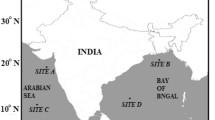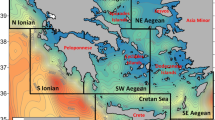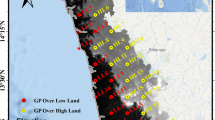Abstract
The estimation of the monthly mean sea-level variations is a key issue in coastal regions’ planning due to their vulnerability to sea-level changes. The objective of this study is to test the digital spatial data and their accuracy for investigation of sea-level-change impact on the coastal area of New York City. Recent investigations show that there is a meaningful correlation between climatic signals’ variations such as sea-level pressure (SLP) and sea-surface temperature (SST), and sea-level changes. In this study, data-driven models are used to explore this relationship over the eastern coastal line of New York. The considered climatic signals are SST and SLP at the nine grid points (with \(2.5^{\circ } \times 2.5^{\circ }\) resolution) around the study region. The most effective predictors of sea-level changes are identified through correlation analysis. Different models of ANFIS (adaptive-network- based FIS) and three artificial neural networks (ANNs) including a multilayer perceptron (MLP), Elman recurrent neural network, and a special class of time-delay neural network (TDNN)—namely IDNN—are used to simulate sea-level changes. An MLP is also developed to hybridize the models’ outputs and provide more accurate estimation of sea level. Even though the results show that the hybrid model can significantly improve the accuracy of sea-level predictions, because of the uncertainties associated with development of the flood maps and evacuation zones, the impact study of sea-level fluctuation remains as a challenge.













Similar content being viewed by others
References
Agrawal JD, Deo MC (2002) Online wave prediction., Marine structuresElsevier, Oxford
Akyilmaz O, Kutterer H (2004) Predicition of earth rotation parameters by fuzzy inference systems. J Geodesy 78:82–93
Chen JL, Shum CK, Wilson CR, Chambers DP, Tapley BD (2000) Seasonal sea level change from TOPEX/Poseidon observation and thermal contribution. J Geodesy 73:638–647
Chowdhury MR, Schroeder Chu PS (2007) ENSO and seasonal sea-level variability-a diagnostic discussion for the US-affiliated Pacific Islands. Theoret Appl Climatol 88:213–224
Clouse DS, Giles CL, Horne BG, Cottrell GW (1997) Time-delay neural networks: representation and induction of finite-state machines. IEEE Trans Neural Netw 8(5):1065–1070
Coulibaly P, Anctil F, Aravena R, Bobée B (2001) Artificial neural network modeling of water table depth fluctuations. Water Resour Res. doi:10.1029/2000WR900368
Douglas BC, Kearney MS, Leatherman SP (2000) Sea level rise history and consequences., International geophysics series 75Academic Press, London
Dubrovin T, Jolma A, Turunen E (2002) Fuzzy model for real-time reservoir operation. J Water Resour Plan Manag 128:66–73
El-Rabbany A, El-Diasty M (2003) A new approach to sequential tidal prediction. J Navig 56:305–314
Haykin S (1999) Neural networks: a comprehensive foundation. Prentice-Hall, Upper Saddle River
Hornik K (1993) Some new results on neural network approximation. Neural Netw 6:1069–1072
Huang W, Foo S (2002) Neural network modelling of salinity variation in Apalachicola River. Water Res 36:356–362
Huang W, Murray C, Kraus N, Rosati J (2003) Development of a regional neural network for coastal water level predictions. Ocean Eng 30:2275–2295
Ingham AE (1992) Hydrography for the surveyor and engineer. Blackwell Science, Oxford
Jang JSR (1993) ANFIS: adaptive-network-based fuzzy inference systems. IEEE Trans Syst Man Cybern 23:665–685
Jelesnianski CP, Chen J, Shaffer WA (1992) SLOSH: sea, lake, and overland surges from hurricanes. NOAA Technical report NWS 48, National Oceanic and atmospheric administration, US department of commerce, (Scanning courtesy of NOAA’s NOS’s Coastal Service’s Center) p 71
Karamouz M, Nazif S, Fallahi M (2013a) Hydrology and hydroloclimatology. CRC Press, New York
Karamouz M, Altayyar Y, Zahmatkesh Z, Damei M (2013b) Assessment of Floodplains in New York City. ASCE World Environ Water Resour Congr 2013:1068–1076
Kazeminezhad MH, Etemad-Shahidi A, Mousavi SJ (2005) Application of fuzzy inference system in the prediction of wave parameters. Ocean Eng 32:1709–1725
Kumar A, Minocha VK (2001) A discussion on backpropagation neural network in tidal-level forecasting. J Waterw Port Coast Ocean Eng 127:54–55
Lee TL, Jeng DS (2002) Application of artificial neural networks in tide-forecasting. Ocean Eng 29:1003–1022
Lee TL, Tsai CP, Jeng DS, Shieh RJ (2002) Neural network for prediction and supplement of tidal record in Taichung harbor. Taiwan Adv Eng Softw 33:329–338
Lee TL (2004) Back-propagation neural network for long-term tidal predictions. Ocean Eng 31(2):225–238
Lin LC, Chang Hk (2008) An adaptive neuro-fuzzy inference system for sea level prediction considering tide-generating forces and oceanic thermal expansion. Terr At Ocean Sci 19(1–2):163–172
Makarynskyy O, Makarynska D, Kuhn M, Featherstone WE (2004) Predicting sea level variations with artificial neural networks at Hillarys Boat Harbour, Western Australia. J Estuarine Coast Shelf Sci 61:351–360
Makarynska D, Makarynsky O (2008) Predicting sea-level variations at the Cocos (Keeling) Islands with artificial neural networks. J Comput Geosci 34:1910–1917
Mandal S (2001) A discussion on back-propagation neural network in tidal-level forecasting. J Waterw Port Coast Ocean Eng 127:54–55
Mamdani EH (1977) Application of fuzzy logic to approximate reasoning using linguistic synthesis. IEEE Trans Comput 26(12):1182–1191
Maqsood I, Riaz Khan M, Abraham A (2004) An ensemble of neural networks for weather forecasting. J Neural Comput Appl 13:112–122. doi:10.1007/s00521-004-0413-4
Mas JF (2004) Mapping land use/cover in a tropical coastal area using satellite sensor data, GIS and artificial neural networks. Estuarine Coast Shelf Sci 59(2):219–230
MATLAB (2010) MATLAB documentation. MathWorks. Retrieved 2010
Medina JR (2001) A discussion on back-propagation neural network in tidal-level forecasting. J Waterway Port Coast Ocean Eng 127:55–57
NOAA (2013) http://csc.noaa.gov/digitalcoast/tools/slrviewer. Accessed 15 Sept 2013
Ozger M, Sen Z (2007) Prediction of wave parameters by using fuzzy logic approach. Ocean Eng 34:460–469
Ponnambalam K, Karray F, Mousavi SJ (2003) Optimization of reservoir systems operation using soft computing tools. Fuzzy Sets Sys 139:451–461
Rajasekaran S, Thiruvenkatasamy K, Lee TL (2006) Tidal level forecasting using functional and sequential learning neural networks. Appl Math Model 30:85–103
Salmi T, Määttä A, Anttila P, Ruoho-Airola T, Amnell T (2002) Detecting trends of annual values of atmospheric pollutants by the Mann–Kendalltest and Sen’s slope estimates-The Excel template application MAKESENS. Ilmatieteenlaitos, Meteorologiska Institutet, Finnish Meteorological Institute, Helsinki
Takagi T, Sugeno M (1985) Fuzzy identification of systems and its applications to modeling and control. IEEE Trans Sys Man Cybern 15:116–132
Tsai CP, Hsu JR-C, Pan KL (2000) Prediction of storm-built beach profile parameters using neural network. In: Proceedings of the 27th international conference coastal engineering, vol 4, ASCE, pp 3048–3061
Ultsch A, Roske F (2002) Self-organizing feature maps predicting sea levels. Inf Sci 144:91–125
Walton TL, Garcia AW (2001) A discussion on back-propagation neural network in tidal-level forecasting. J Waterway Port Coast Ocean Eng 127:57–58
Acknowledgments
This paper is dedicated to the late Mr. Mehdi Kia who died at age 30 from liver disease. He will be remembered and we cherish his dedication to science and engineering.
Author information
Authors and Affiliations
Corresponding author
Rights and permissions
About this article
Cite this article
Karamouz, M., Kia, M. & Nazif, S. Prediction of Sea Level Using a Hybrid Data-Driven Model: New Challenges After Hurricane Sandy. Water Qual Expo Health 6, 63–71 (2014). https://doi.org/10.1007/s12403-014-0119-5
Received:
Revised:
Accepted:
Published:
Issue Date:
DOI: https://doi.org/10.1007/s12403-014-0119-5




